| Article ID | Journal | Published Year | Pages | File Type |
|---|---|---|---|---|
| 10972926 | International Journal for Parasitology | 2007 | 15 Pages |
Abstract
The malaria parasite, Plasmodium falciparum, exports proteins beyond the confines of its own plasma membrane, however there is debate regarding the machinery used for these trafficking events. We have generated transgenic parasites expressing chimeric proteins and used immunofluorescence studies to determine the locations of plasmodial homologues of the COPII component, Sar1p, and the Golgi-docking protein, Bet3p. The P. falciparum Sar1p (PfSar1p) chimeras bind to the endoplasmic reticulum surface and define a network of membranes wrapped around parasite nuclei. As the parasite matures, the endomembrane systems of individual merozoites remain interconnected until very late in schizogony. Antibodies raised against plasmodial Bet3p recognise two foci of reactivity in early parasite stages that increase in number as the parasite matures. Some of the P. falciparum Bet3p (PfBet3p) compartments are juxtaposed to compartments defined by the cis Golgi marker, PfGRASP, while others are distributed through the cytoplasm. The compartments defined by the trans Golgi marker, PfRab6, are separate, suggesting that the Golgi is dispersed. Bet3p-green fluorescent protein (GFP) is partly associated with punctate structures but a substantial population diffuses freely in the parasite cytoplasm. By contrast, yeast Bet3p is very tightly associated with immobile structures. This study challenges the view that the COPII complex and the Golgi apparatus are exported into the infected erythrocyte cytoplasm.
Related Topics
Life Sciences
Immunology and Microbiology
Parasitology
Authors
Akinola Adisa, Sarah Frankland, Melanie Rug, Katherine Jackson, Alexander G. Maier, Peter Walsh, Trevor Lithgow, Nectarios Klonis, Paul R. Gilson, Alan F. Cowman, Leann Tilley,
